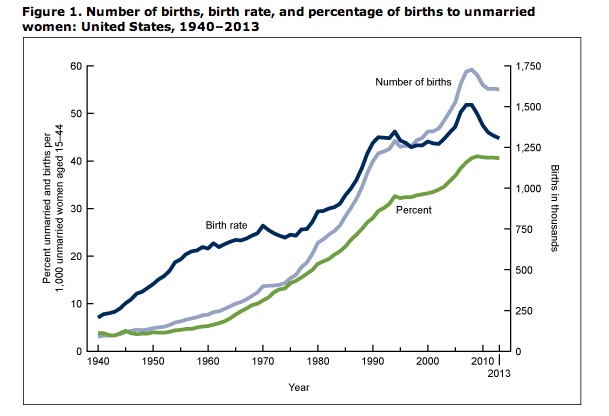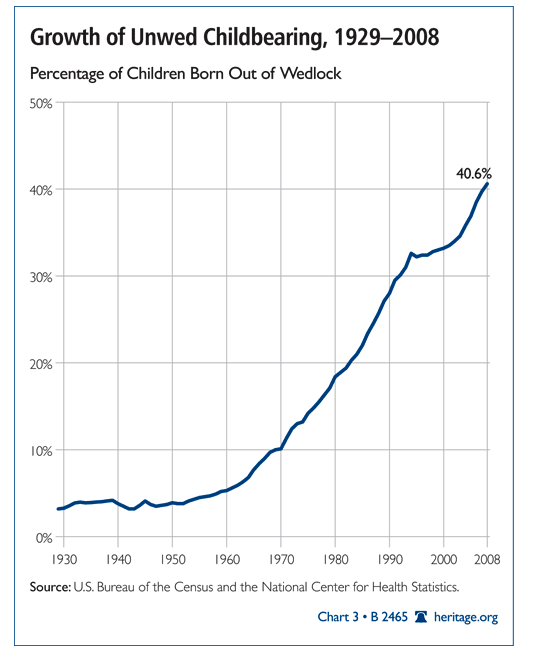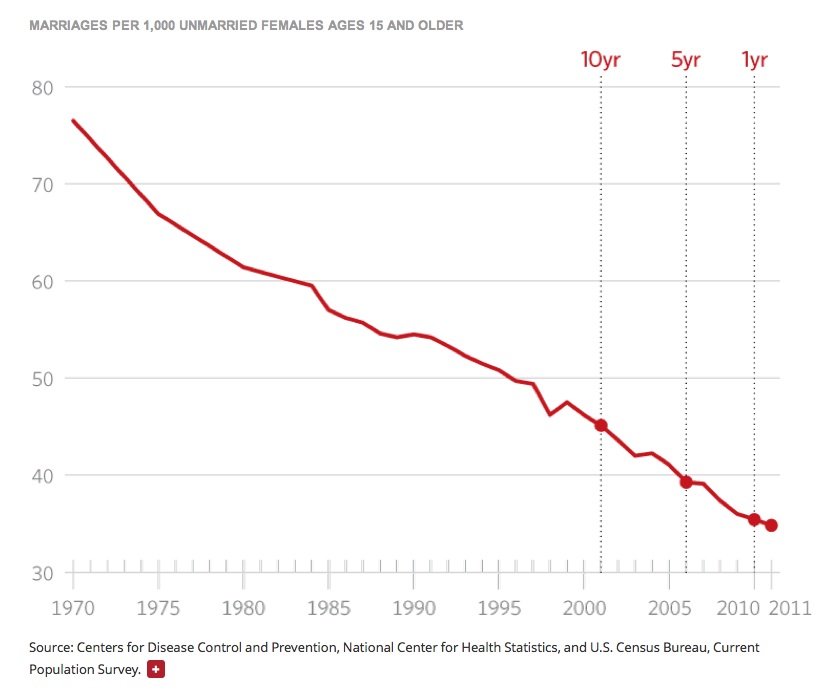
Catherine Rampell has declared in the Washington Post that, in America, “Sex is for rich people. Non-procreative sex in particular. How else would you explain the trap that we’re laying for poor people who deign to get it on?”
Rampell argues that if only poor people in America could get free birth control and more comprehensive sex education, have “easy access” to abortions in unregulated clinics, and receive more government-sponsored childcare by expanding the welfare state, then unwanted pregnancies would be a thing of the past and Americans would live happily ever after.
Oh, the joy of a liberal utopia.
Rampell doesn’t pause to consider other factors that have seriously contributed to the disparity between the rich and poor on out-of-wedlock births. Instead of looking at the issue in terms of personal choice regarding marriage and childbirth, as well as personal responsibility, and respecting all people as rational human beings capable of self-government, she concludes that a “trap” is being laid; someone must be doing something to these women or not enough for them. Neither is truly the case.
Taxpayers Sponsor Gobs of Sex-Related Items for Poor Women
Let’s take these issues one at a time. First, access to free birth control and family planning services: Low-income women already have access to free birth control through Title X, which Rampell says has been “gutted.” But this isn’t true. According to the most recent Title X Family Planning Annual Report, “between 1999 and 2012, inflation-adjusted (constant 2012 dollars) total revenue increased 3%, from $1.2 billion in 1999 to almost $1.3 billion in 2012.”
While some sources of revenue for Title X decreased (including a relatively slight decrease in appropriated funds), revenue from Medicaid for family planning services “more than tripled from $166.2 million in 1999 to $499.2 million in 2012.” There were also increases from other sources, “including an 85% increase in private and other third-party reimbursements, an 18% increase in local government revenue, and a 12% increase in ‘other sources.’”
When it comes to taking care of single women after they have babies out of wedlock, the federal government operates more than “70 means-tested welfare programs that provide cash, food, housing, medical care, and targeted social services to poor and low-income persons,” Robert Rector writes at the Heritage Foundation in a report on child poverty. “In fiscal year 2010, federal and state governments spent over $400 billion on means-tested welfare for low-income families with children. Roughly three-quarters of this welfare assistance, or $300 billion, went to single-parent families. Most non-marital births are currently paid for by the taxpayers through the Medicaid system, and a wide variety of welfare assistance will continue to be given to the mother and child for nearly two decades after the child is born.” While we don’t live in a perfect world where everyone’s needs are taken care of, the accusation that Americans don’t care about poor unwed mothers is a severe mischaracterization.
As for opposition to the contraception mandate in Obamacare, the Hobby Lobby case was not about denying women their rights to contraception as has been popularly and erroneously claimed; it was about removing pills that cause abortions from the list of insured drugs. That left 16 out of the 20 approved forms of contraception that insurance would cover, including condoms, diaphragms, sponges, cervical caps, combined pills, the mini pill, extended/continuous-use birth control pills, patches, rings, injections, rods, vasectomies, and sterilization surgeries. This hardly counts as denying women’s reproductive rights.
According to a national report on intended and unintended births, American women who are fertile, sexually active, but not currently using a method of modern contraception give many reasons for not using birth control—“most of which have little to do with affordability or physical access.” Most of the women surveyed didn’t use contraception because they didn’t think they’d get pregnant (it’s not clear whether this is a lack of knowledge or simply denial). Others didn’t want to deal with the side effects of birth control and chose to risk getting pregnant. Still others simply didn’t expect to have sex when they did. They weren’t on birth control and evidently didn’t have a condom, but they chose to have sex anyway.
The ‘Unintended Pregnancy’ and ‘Uneducated Girls’ Myths
The government report interprets these findings as women simply not having enough sex education. Women, the report says, are misinformed about side effects, and they need to be better aware of all options available as well as how birth control actually works. Kathryn Edin, professor of public policy at Harvard, is the nation’s most distinguished researcher on low-income single mothers, and, Rector notes, “her findings overturn much conventional wisdom about ‘unintended’ pregnancy, out-of-wedlock childbearing, and low-income single parents.” Edin says the popular perception that nonmarital childbirth is the result of accidental pregnancies among teenage girls who don’t have enough or proper information about birth control isn’t true.
“Edin explains that children born out of wedlock are ‘seldom conceived by explicit design, yet are rarely a pure accident either,’” Rector writes. “Young single mothers typically ‘describe their pregnancies as “not exactly planned” yet “not exactly avoided”.… Only a few were using any form of contraception at all when their “unplanned” child was conceived.’ But this lack of contraceptive use was not due to a lack of knowledge about or access to contraceptives.” It was a matter of choice.
Rampell and others would disagree. They see the root problem as a sex-ed gap between the rich and the poor. If only there were more sex education, poor people would stop having babies.
When it comes to sex education, studies are all over the place about what is effective. Every state in the nation is involved in some form of sex education for public school children. According to the Guttmacher Institute, most teens receive formal education about sexually transmitted diseases and abstinence. However, about one-third of teens haven’t received any formal instruction about contraception. While this isn’t as high as the 84% who are taught abstinence, it’s still pretty high.
Guttmacher observes that one factor that contributes to high-risk sexual behavior is “exposure to high levels of sexual content on television,” which is “associated with an increased risk of initiating sexual activity, as well as a greater likelihood of involvement in teen pregnancy.” Interestingly, Rampell makes no mention of high levels of sexual content on television as a contributing factor to unintended pregnancies, neither do those who suggest that the best solution to low-income nonmarital births is to encourage young poor women to use effective birth control devices such as IUDs, IUSs, implants, and injections and increase awareness of these devices through state-run social marketing campaigns.
Pushing IUDs Based on Poor Assumptions
While a report from the Brookings Institution mentions that IUDs can cause perforation and infection, it says the devices are generally safe for adolescents, which is consistent with recommendations from the American Academy of Pediatrics. However, thousands of women (more than 70,000 since 2000) have issued complaints about some IUDs, such as Mirena, manufactured by Bayer Pharmaceuticals. While the IUDs of today are better than those of the past, they still come with risks, and many women are choosing not to use them.
The push for IUD use as a solution to unintended pregnancies is tied to the belief, based on some findings, that abstinence education doesn’t work. As Rampell says, people are going to have sex no matter what, so you might as well prepare them for it—even it that means using risky forms of birth control (no matter how small that risk might be). Yet Guttmacher makes a brief, but significant, observation about abstinence education: “Although there is no evidence indicating that federally-funded abstinence-only-until-marriage education is effective, a recent randomized controlled trial found that in specific cases, abstinence-only education programs that are specifically tailored to the local community and do not criticize contraceptives nor advocate abstinence until marriage can be effective in delaying sexual debut among younger teens.”
Guttmacher doesn’t expand, but there is some indication that in local environments, this kind of balanced education works. It is reasonable to conclude that these “local environments” include parental and maybe religious-based involvement. According to Rector, parental involvement and children growing up in a home where their mother and father are present is essential to reducing nonmarital births. Many studies conclude that girls are at an increased risk of becoming pregnant out of wedlock when they are raised only by one parent, especially when the father is the absent one.
“Compared to girls raised in similar married families, girls from single-parent homes are more than twice as likely to have a child without being married, thereby repeating the negative cycle for another generation,” Rector writes. One of the differences between low-income girls getting pregnant compared to their high-income counterparts isn’t money, but the fact that more high-income girls come from two-parent homes where they have the benefit of their father’s attention, guidance, and nurture. The father in the home is not just beneficial because of economic reasons, but because of the irreplaceable influence he has on his children.
Father Absence Increases Subsequent Generations’ Unwed Childbearing
Unfortunately, more and more children are being raised without their fathers. Marriage has declined for all Americans, rich and poor, but it has seen a greater decline among the poor. Marital childbearing used to be the norm in the United States. “When President Lyndon Johnson launched the War on Poverty in 1964,” Rector writes, “93 percent of children born in the United States were born to married parents.” In 2007, only 59 percent of all births occurred to married couples. The decline in marriage has fallen by approximately 50 percent since the 1970s:
Today, one in three children are being raised without a father, and nearly half of those live below the poverty line. In 1960, only 11 percent of American children lived without their fathers. Before that, there were hardly any out-of-wedlock births compared to today, as seen in the chart below from the Centers for Disease Control. Note, however, that there has been a recent downturn in the birth rate. After increasing between 2002 and 2007, birth rates for unmarried women in all race groups were lower in 2012 than in 2007. It is speculated that the reason for this is a bad economy, and we don’t know if these numbers will hold or if the nonmarital birth rate will once again rise.
 Notice that, in 1940, there were very few nonmarital births. Yet Rampell tells us that those who advocate marriage and abstinence suffer from a “right-wing delusion,” that they rely on a “fundamental miscalculation about human nature” because you can’t control people’s libidos. People are going to have out-of-wedlock sex because that’s who they are as humans and that desire can’t be denied; it must simply be managed with a really good form of birth control.
Notice that, in 1940, there were very few nonmarital births. Yet Rampell tells us that those who advocate marriage and abstinence suffer from a “right-wing delusion,” that they rely on a “fundamental miscalculation about human nature” because you can’t control people’s libidos. People are going to have out-of-wedlock sex because that’s who they are as humans and that desire can’t be denied; it must simply be managed with a really good form of birth control.
While you certainly can’t “legislate away libido,” obviously we know from history that people have the ability to exercise self-control. If having casual sex is a matter of human nature and a tyrannical libido that simply can’t be denied or governed, then there would have been just as many nonmarital births in 1940 as today, if not more (because of less birth control availability). So what is the difference between the women in 1940 and the women today? Has human nature magically changed? Did the women in 1940 not have libidos?
With all due respect to Rampell, her chiding of the right-wing moralists is based on faulty logic at best. Human nature hasn’t changed. Women in 1940 were no different than women today—libido and all. What has changed are the social norms and morals that help people keep their libido in check, that encourage self-government and self-control. The value of marriage, which is a strong bulwark against sexual promiscuity as well as poverty, has been rejected as important and vital to a flourishing society.
Yes, Women Can Choose to Not Have Sex
Today, we throw up our hands and say people are going to have causal sex so we might as well just deal with it and get them sterilized—it’s human nature, after all, and we’re powerless before it. But this is a lie. We don’t have to be enslaved to our base desires; we can choose not to have sex. We can choose to wait to have children until after we’re married. We can choose to raise children in a two-parent home, which is best for them. The problem is, as individuals and as a society, we don’t want to make that choice, and we’ve abandoned all the traditional mechanisms that help us do what’s best for ourselves and our children.
Rampell says data shows just how hard it is “to keep those unmarried libidos in check.” Do we really need data to tell us that? And doing so is even more difficult if we have abandoned the restraints that help us—the values that keep us from having sex until marriage and the external social restraints that both inform us that marriage is best and that birthing children out of wedlock is immoral and unhealthy. Yes, I do know how shocking those words sound as they echo in a world empty of morality and real, sacrificial love.
Sadly, we have loosened those restraints, and now our libidos are truly running wild—encouraged by sexualized messaging in music, pop culture, and entertainment. Sex education is a weak effort at restraining those impulses, and in some ways it encourages them, especially when casual sex is presented not only as inevitable but good.
Sex education is not completely effective because it offers only biological instruction with no moral or familial framework or traditional values that have historically played a major role in checking our libidos. At a time when few promote marriage and traditional values on sex, sex education and prevention efforts have been in full force. And yet, STDs, which are prominently discussed in sex education classes across the nation, have been on the rise (even among those who are over 50 years old and have a penchant for reading the popular erotica novel “Fifty Shades of Grey”—I know, strange, but there are British medical reports about the correlation).
Where Are the Premarital Sex Warning Campaigns?
One thing is for sure, while there are a lot of messaging campaigns about a variety of issues, one can hear only crickets chirping when it comes to promoting marriage and traditional values about sex. Regarding this social silence, Rector makes an insightful analogy between having a child outside of marriage and dropping out of school, both of which are economically detrimental:
[D]ropping out of school and having a child outside of marriage have one crucial difference. Everyone in our society is told incessantly from childhood on that dropping out of school will harm one’s future; despite this constant refrain, a great many still drop out each year. In bold contrast, young people in low-income communities are never told that having a child outside of marriage will have negative consequences. They are never told that marriage has beneficial effects. The schools, the welfare system, the health care system, public authorities, and the media all remain scrupulously silent on the subject. In the face of this pervasive social silence, it should be no surprise that out-of-wedlock childbearing has become the norm in so many communities.
Imagine how high the school dropout rate might be if, for 50 years, lower-income youth were never told that failing to finish school would harm their future.
The following chart shows how out-of-wedlock childbearing has increased over the years:
 Most of these nonmarital births occur to women who are struggling to make ends meet. “More than two-thirds of births to women who were high school dropouts occurred outside of marriage. . . . By contrast, among women with at least a college degree, only 8 percent of births were out of wedlock.” Rampell says the reason for this disparity is that low-income women aren’t getting the sex education they need. While it’s certainly true that increased contraception use and abortion lower birth rates, sex education isn’t the only solution. Again, back in 1940 when we didn’t have this problem, there wasn’t any government-funded birth control or sex education. Also, nonmarital birth rates have continued to go up despite increased sex education and access to birth control. There has been a leveling off of births among teens, but nonmarital births among older low-income women continue to rise.
Most of these nonmarital births occur to women who are struggling to make ends meet. “More than two-thirds of births to women who were high school dropouts occurred outside of marriage. . . . By contrast, among women with at least a college degree, only 8 percent of births were out of wedlock.” Rampell says the reason for this disparity is that low-income women aren’t getting the sex education they need. While it’s certainly true that increased contraception use and abortion lower birth rates, sex education isn’t the only solution. Again, back in 1940 when we didn’t have this problem, there wasn’t any government-funded birth control or sex education. Also, nonmarital birth rates have continued to go up despite increased sex education and access to birth control. There has been a leveling off of births among teens, but nonmarital births among older low-income women continue to rise.
“The decline in marriage and growth of out-of-wedlock birth is not a teenage issue,” Rector writes, “it is the result of a breakdown in relationships between young adult men and women.”
Many Poor Women Choose Children Before Marriage
As Edin said, the increase of nonmarital births among low-income women is not simply because they aren’t educated about contraception or because they don’t have free access to birth control (which they do), it’s because they are choosing to have children before marriage despite the difficulties that come with it. According to Edin in her book, “Promises I Can Keep,” “Most low-income non-married mothers see children not merely as desirable, but as a ‘necessity.’ Without children, their lives are hollow and chaotic; having children is a ‘heroic’ choice that rescues them from emptiness. For many, parenthood is the point ‘at which they can really start living.’”
“Critically, almost none of the lower-income women who have a child out of wedlock feel that it is important to be married before having children,” Rector writes. “Although roughly half of non-married mothers were cohabiting with the father at the time of birth (nearly 75 percent were in some sort of romantic relationship with the father), these relationships are usually of short duration and unstable. Mutual understanding and commitment are lacking, and although the couples usually think and speak favorably about marriage, most tend to drift apart after the child is born.”
In other words, the strong desire for women to have children coupled with the now-common belief that marriage isn’t necessary for having children explains the increase of nonmarital births in low-income communities. “While most non-marital pregnancies are not deliberately planned, they are also not seriously avoided,” Rector writes. This bears out in polls in which 17.3 percent of women say they didn’t use contraception because they didn’t care if they got pregnant. This isn’t a matter of education; this is a matter of choice.
Rector says this choice is not thrust on most of the women making it because of a lack of marriageable men. More than 40 percent of children are now born outside of marriage. Does this mean 40 percent of young adult men in America are non-marriageable? “In reality, while some of the fathers are not suitable marriage partners, most would be. Three-quarters of non-married fathers are still romantically involved with the mother at the time of birth. Among these men, alcohol, drug, and physical abuse are infrequent.”
Rampell makes one other point besides the need for more sex education and access to birth control. She says there needs to be more “easy access” to abortions. The term itself is misleading because access is not the issue, safety is. We’ve seen results of unregulated clinics and the horrific consequences for low-income women in the Kermit Gosnell case in which infants were beheaded, severed baby feet were kept in jars, an infant was left screaming after it was delivered alive during an abortion, and an adult patient, Karnamaya Mongar, died of a heart attack and in severe pain after getting an abortion. Is the push for regulated clinics where women will be safe really that unreasonable?
Try Some Pro-Woman and Pro-Child Solutions for Once
When it comes to finding solutions that will help low-income single mothers, we need to do more than just dish out contraceptives (which will be ineffective for those who are actually choosing to have babies out of wedlock), herd them into unregulated abortion clinics, give them “comprehensive” sex education that fails to factor in the spiritual and moral dimension of human beings, and then continue their dependence on government and the cycle of poverty by increasing welfare programs.
Are these really pro-woman or pro-child solutions? Why don’t we try something we know actually works in reducing poverty, making our children’s lives better, and stabilizing our communities? Why don’t we endorse marriage and traditional values about sex? Rein in the sexualized culture by promoting the dignity of women (and men) instead of degrading them through sexualization and talking about them as if they have no ability to control their own libidos, as if they’re just a bunch of mindless, soulless lust bunnies incapable of saying “no” to themselves.
I can just hear the mockery now and the hysterical screams of “Don’t stigmatize my choice to have sex!” But no one is stigmatizing sex, let alone your choice to have it. What’s being stigmatized in our culture is marriage and the choice not to have sex. What I’m saying is that we need to turn that trend around, not because sex isn’t fun, but because sex within marriage is much better—and it’s definitely better for the children who are products of it.
So, how about trying something new? How about communicating a pro-marriage message and strengthen marriage in low-income communities, as Rector recommends?
- “Encourage public advertising campaigns on the importance of marriage.”
- “Provide marriage education programs in high schools and with a high proportion of at-risk youth.”
- “Strengthen federal abstinence education programs that provide critical information on the value of marriage to adults, children, and society.” And if you think comprehensive sex education is better, then at least make it truly comprehensive and add information about the importance of marriage.
- “Make voluntary marriage education widely available to interested couples in low-income communities. Provide marriage education materials and referrals in Title X birth control clinics.”
- Finally, reduce the penalties against marriage in the welfare system.
People like Rampell can scoff at these suggestions and say they won’t work because people are enslaved to their libidos, but some of us have a higher view of women—that they don’t have to be controlled by their base desires, by poverty, by fear, by dependency—all of which drive us to more constricted and unhappy lives.
We can do better. We have done better. And we can be better again.










